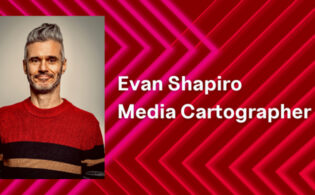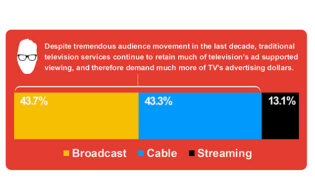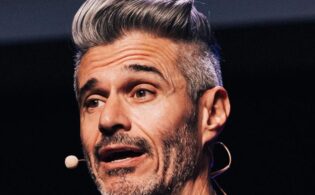Media cartographer Evan Shapiro opened the lineup of MIPTV Media Mastermind keynotes in Cannes today by calling on IP owners to rethink how they distribute and monetize content.
Shapiro pens the Media War & Peace newsletter and serves as a professor at NYU at Fordham University. He has compiled a well-regarded Media Universe Map since 2020 and delivered exclusive findings from his research in Cannes today. The award-winning producer also previously ran IFC, Sundance TV and Seeso.
“Everything that’s happening in the ecosystem is changing,” Shapiro said. “Television is this great product that everybody on the face of the Earth uses. The technology of streaming has really shifted the way we think about how television is viewed, how it’s consumed and the economics of it. But just making TV, just putting it on, doesn’t change the economic underpinning, the financial well-being of the ecosystem. We need to reshape the way we think about how television is consumed and distributed and, ultimately, the economy underneath it. We have to change our mindset completely. We can’t just shift and tweak.”
Evolving is crucial in the next three years, Shapiro stressed. “Those who don’t will fail. I’m here to beg for a complete rethink on how we approach the distribution of and the economics of our television industry.”
Shapiro’s Media Universe map shows the dominance of the tech giants: Apple, Microsoft and Alphabet. “These companies use their resources from iPhones and Google searches to get into your business and put you out of it. They are going to steal share from you using money from high-revenue things like AWS and Google Search and Chrome. That’s why they have to be on the same map.”
He continued, “When you think about how the consumer thinks about media, you have to put all these things in your head at the same time. Your intellectual property has to traverse all of these platforms and all of these different ways of consumption if you’re going to scratch all the itches that the consumers you are trying to satisfy are looking to scratch. So when you think about how you make intellectual property, don’t only think about television. Think about where else it can go because you are leaving a tremendous amount of value for yourself and for your consumer if you don’t think about how to reach them on several different platforms with each piece of intellectual property. When you think about the financial underpinnings of this ecosystem, don’t only think about streaming or linear, audio or video, social or TV. They are all colliding in the mind of a consumer, on the device of the consumer. We have to really begin to think about things not as an ‘either-or’ but much more as a ‘yes, and.’ Don’t reject something in the ecosystem simply because you’ve never done it before because it’s not part of the tradition of making television. We have to adapt.”
The consumer doesn’t think in terms of paid or free, linear or on-demand, streaming or broadcast—they want a combination. “We have to live inside their brains and provide them the ‘yes, and.’”
Shapiro continued, “We have to stop thinking about the gatekeeper economy or the creator economy. They are going to coexist, and they do coexist on platforms.”
Shapiro has dubbed the creator economy the community economy. “The value is not going to be driven by reach anymore. It’s going to be driven by engagement and passion and love of the content that you’re putting out there. But when you think about how you make money in your business, separating these two things into completely siloed ecosystems is going to be a mistake. You’re going to get a tremendous amount of value from your IP, from your platform, for your brand. Half of the impressions you’re going to generate or should generate on a moving forward basis should come from the community economy.”
Shapiro went on to note that there’s a misconception about younger consumers not wishing to pay for content. “They do. We’ve trained the three youngest generations, the three most diverse generations, to pay for the content they love most. The younger consumers do want to pay, when it’s merited. There’s this blending of financial requirements when someone thinks about how they are going to consume their content. And they are totally comfortable moving from pay to free.”
As for what Gen Z looks for in platforms they will pay for, Shapiro said relevant content tops the list; “cost is number five, behind content, originals, refresh rate and library size. It’s comparable to ease to use.”
Consumers want a mix of lower fees with some ads, free with maximum ads or paid with no ads. “But when you look at people under the age of 35, paid with no ads is the number one way they prefer to watch or listen to or read content.”
In the year ahead, “only 7 percent said they plan to stick with the subscription services they have right now. That means 93 percent of consumers who subscribe to a platform are considering changing up next month. There’s massive subscription fatigue going on. Forty percent of consumers occasionally or regularly subscribe to something for one piece of content, binge it and get out. That serial churn is creating a problem for subscription video businesses. In the fourth quarter of 2022, the SVOD ecosystem brought in 41 million new subscribers. They kept 7.5 million. That’s not a sustainable business.”
Social media and premium SVOD rank as first and second in consumer media usage worldwide, Shapiro added.
Referencing the increasing presence of companies like Google and Samsung in the content business, Shapiro noted: “We’ve gone from the idea of frenemies to what I call collabor-gators. Do not see the Googles and the Amazons only as enemies because for many of us, we have no choice but to go through them to get to the consumers. Google controls 70 percent of the phones on planet Earth. It is the fastest-growing CTV OS platform.”
Shapiro went on to highlight the strength of the public broadcasters in Europe’s streaming ecosystem. “The public broadcasters are taking up more time on streaming than Netflix is. And they’re getting into the neighborhood of YouTube and kicking Amazon’s and Disney’s asses. When you look at how much linear television Europeans are watching, think about how much attention the local broadcaster is getting as opposed to YouTube or Netflix or Amazon. So there’s this new mindset opening up here where the public broadcasters are moving to streaming and they’re capturing a tremendous amount of attention while they’re maintaining their linear television advantage. And the combination of them is really taking up a tremendous amount of attention in each market. Don’t only think about streamers as coming in and competing with your television brand. Think about them as a part of the entertainment diet that every consumer has. And your linear television experience can be relocated to streaming and satisfy a tremendous amount of consumers’ needs on an ongoing basis.”
Shapiro also talked about the buzz around FAST channels. “There’s this concept now in the U.S. that FAST is going to replace cable television. I understand that FAST is this red-hot topic that everybody wants to talk about right now. But the economics of a free ad-supported streaming platform without any fees or subscriptions, for an American who came from the cable business, that’s a little bit of an anomaly for me to think about. Also, there is this massive war going on on FAST right now where the proliferation of channels around the world is not necessarily underpinned by a consistent content strategy.”
Local exclusives will be key to services worldwide for subscriber retention and advertiser value, Shapiro said. “And, when you think about streaming, FAST and AVOD, SVOD with ads are going to combine into a new economic model. We have to stop thinking of free and paid as two different experiences. We have to stop thinking of AVOD and FAST and SVOD as three different experiences. We have to stop thinking about walled gardens as an answer to a business model. The paradox of choice is creating choice paralysis, and the economic underpinnings of our business are falling apart as a result of that. We need to blend these things together into an easy-to-use television ecosystem that the consumer can embrace and not have to navigate.”
In the U.S., for consumers under 45, “free streaming is now the number one way to watch video on a daily basis. Paid streaming is number two. This is daily or weekly. The utility programming of live sports, news, local, recurring, refreshed on an ongoing basis, these are going to be major drivers of the economics of television. When you look at this ecosystem, you have to think about blending all of them into one. Not keeping them in walled gardens apart from each other. You have to think about this entire bundle that the consumer is putting into their pocket on a daily basis and skipping from social to video to audio to reading to podcasts to FAST to cable. If you’re not addressing their needs on a real-time basis, you’re going to lose to the platforms that do. You’re going to lose to YouTube, which is refreshed every day and is urgent every day. You’re going to lose to the players who are providing a regular diet of necessary content.”
Social video is competing directly with television, Shapiro explained. “You have to seek out those parts of the creative economy. If you’re selling to gatekeepers and platforms, great. Good for you. But if you’re a publisher or content creator and you’re thinking you can change your entire business model to the gatekeeper economy, you are as fucked as they are. Look at their earnings reports. They’re in chaos right now. And if you are hitching your wagon to their star, that star is going to be a black hole at some point soon. You have to look at the community economy and the gatekeeper economy as two interesting parts of the same home. You have to think about this entire transom of services that the consumer sees as their own personal media bundle. You have to think about the battle of the bundles that’s happening right now inside the devices that we all carry around. And have to think about your intellectual property across all these different elements of the consumer experience: video, audio, social, gaming, commerce, free, paid, B2B and B2C. This is the true way to satisfy the consumers you’re trying to reach on an ongoing basis. This is the only way to rethink what we’re doing right now. We can’t redesign the bathroom in a house that’s burning down. That only leaves you with a really nice toilet and a whole bunch of smoking crap. You need to rethink how you reach your consumer and how the value chain between you and your consumers will work.”






